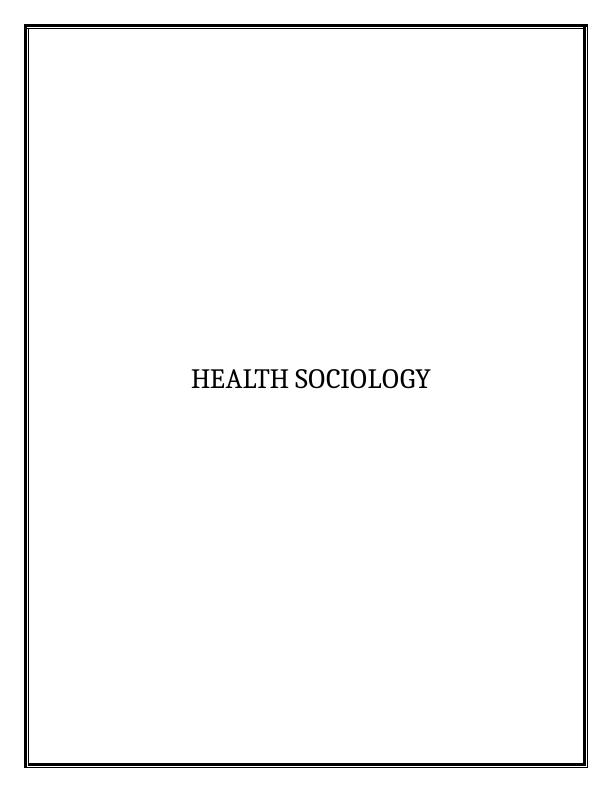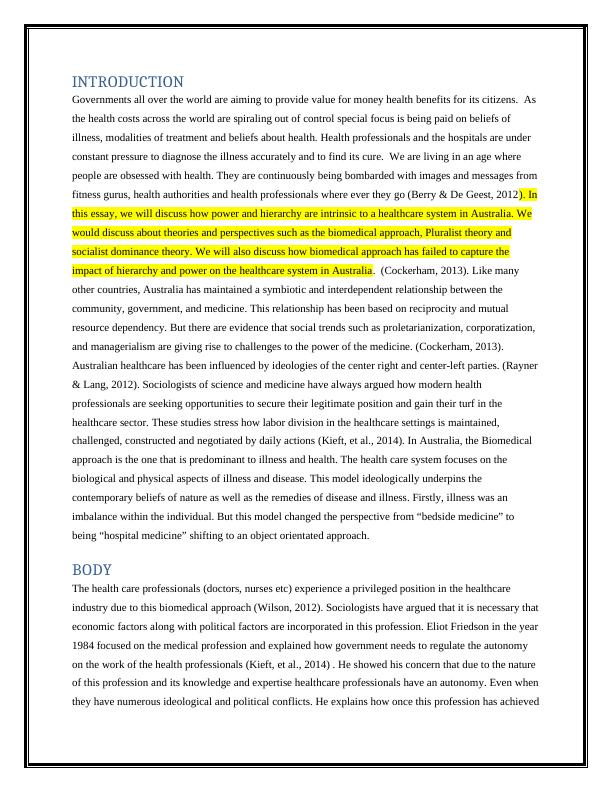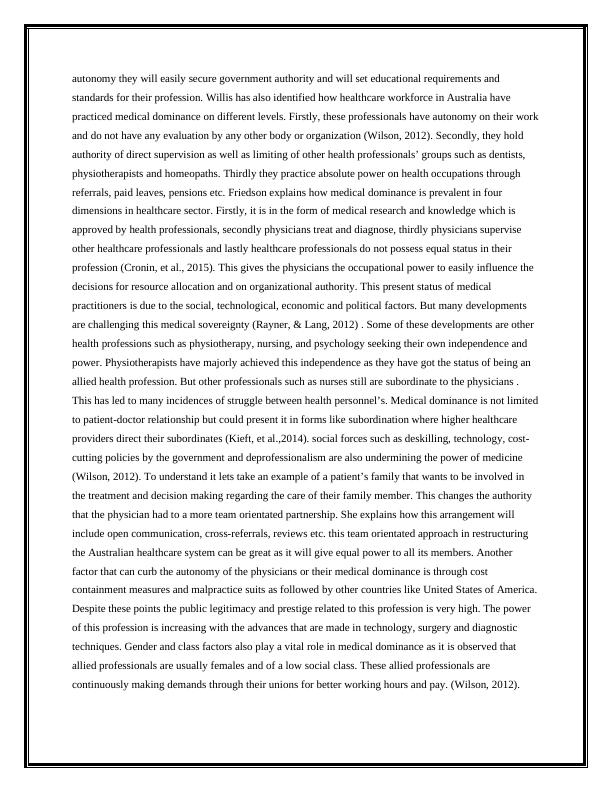Health SOCIOLOGY INTRODUCTION
Added on 2020-03-28
8 Pages3476 Words179 Views
HEALTH SOCIOLOGY

INTRODUCTIONGovernments all over the world are aiming to provide value for money health benefits for its citizens. As the health costs across the world are spiraling out of control special focus is being paid on beliefs of illness, modalities of treatment and beliefs about health. Health professionals and the hospitals are under constant pressure to diagnose the illness accurately and to find its cure. We are living in an age where people are obsessed with health. They are continuously being bombarded with images and messages fromfitness gurus, health authorities and health professionals where ever they go (Berry & De Geest, 2012). Inthis essay, we will discuss how power and hierarchy are intrinsic to a healthcare system in Australia. We would discuss about theories and perspectives such as the biomedical approach, Pluralist theory and socialist dominance theory. We will also discuss how biomedical approach has failed to capture the impact of hierarchy and power on the healthcare system in Australia. (Cockerham, 2013).Like many other countries, Australia has maintained a symbiotic and interdependent relationship between the community, government, and medicine. This relationship has been based on reciprocity and mutual resource dependency. But there are evidence that social trends such as proletarianization, corporatization, and managerialism are giving rise to challenges to the power of the medicine. (Cockerham, 2013).Australian healthcare has been influenced by ideologies of the center right and center-left parties. (Rayner& Lang, 2012). Sociologists of science and medicine have always argued how modern health professionals are seeking opportunities to secure their legitimate position and gain their turf in the healthcare sector. These studies stress how labor division in the healthcare settings is maintained, challenged, constructed and negotiated by daily actions (Kieft, et al., 2014). In Australia, the Biomedical approach is the one that is predominant to illness and health. The health care system focuses on the biological and physical aspects of illness and disease. This model ideologically underpins the contemporary beliefs of nature as well as the remedies of disease and illness. Firstly, illness was an imbalance within the individual. But this model changed the perspective from “bedside medicine” to being “hospital medicine” shifting to an object orientated approach. BODYThe health care professionals (doctors, nurses etc) experience a privileged position in the healthcare industry due to this biomedical approach (Wilson, 2012). Sociologists have argued that it is necessary thateconomic factors along with political factors are incorporated in this profession. Eliot Friedson in the year1984 focused on the medical profession and explained how government needs to regulate the autonomy on the work of the health professionals (Kieft, et al., 2014) . He showed his concern that due to the nature of this profession and its knowledge and expertise healthcare professionals have an autonomy. Even whenthey have numerous ideological and political conflicts. He explains how once this profession has achieved

autonomy they will easily secure government authority and will set educational requirements and standards for their profession. Willis has also identified how healthcare workforce in Australia have practiced medical dominance on different levels. Firstly, these professionals have autonomy on their workand do not have any evaluation by any other body or organization (Wilson, 2012). Secondly, they hold authority of direct supervision as well as limiting of other health professionals’ groups such as dentists, physiotherapists and homeopaths. Thirdly they practice absolute power on health occupations through referrals, paid leaves, pensions etc. Friedson explains how medical dominance is prevalent in four dimensions in healthcare sector. Firstly, it is in the form of medical research and knowledge which is approved by health professionals, secondly physicians treat and diagnose, thirdly physicians supervise other healthcare professionals and lastly healthcare professionals do not possess equal status in their profession (Cronin, et al., 2015). This gives the physicians the occupational power to easily influence the decisions for resource allocation and on organizational authority. This present status of medical practitioners is due to the social, technological, economic and political factors. But many developments are challenging this medical sovereignty (Rayner, & Lang, 2012) . Some of these developments are other health professions such as physiotherapy, nursing, and psychology seeking their own independence and power. Physiotherapists have majorly achieved this independence as they have got the status of being an allied health profession. But other professionals such as nurses still are subordinate to the physicians . This has led to many incidences of struggle between health personnel’s. Medical dominance is not limitedto patient-doctor relationship but could present it in forms like subordination where higher healthcare providers direct their subordinates (Kieft, et al.,2014). social forces such as deskilling, technology, cost-cutting policies by the government and deprofessionalism are also undermining the power of medicine (Wilson, 2012). To understand it lets take an example of a patient’s family that wants to be involved in the treatment and decision making regarding the care of their family member. This changes the authority that the physician had to a more team orientated partnership. She explains how this arrangement will include open communication, cross-referrals, reviews etc. this team orientated approach in restructuring the Australian healthcare system can be great as it will give equal power to all its members. Another factor that can curb the autonomy of the physicians or their medical dominance is through cost containment measures and malpractice suits as followed by other countries like United States of America.Despite these points the public legitimacy and prestige related to this profession is very high. The power of this profession is increasing with the advances that are made in technology, surgery and diagnostic techniques. Gender and class factors also play a vital role in medical dominance as it is observed that allied professionals are usually females and of a low social class. These allied professionals are continuously making demands through their unions for better working hours and pay. (Wilson, 2012).

End of preview
Want to access all the pages? Upload your documents or become a member.
Related Documents
Hierarchy and Power in Australia Health Care Systemlg...
|9
|3350
|462
Sociological Health Theories and their Impact on Australia's Healthcare Systemlg...
|11
|3231
|151
Medical Power and Hierarchy in Australialg...
|10
|3143
|146
Hierarchy and Power in Australian Healthcare Systemlg...
|13
|3703
|143
Hierarchy and Power in Healthcare system Australialg...
|12
|3464
|301
Hierarchy and Power in Australian Health Care System: A Sociological Perspectivelg...
|11
|2899
|394
